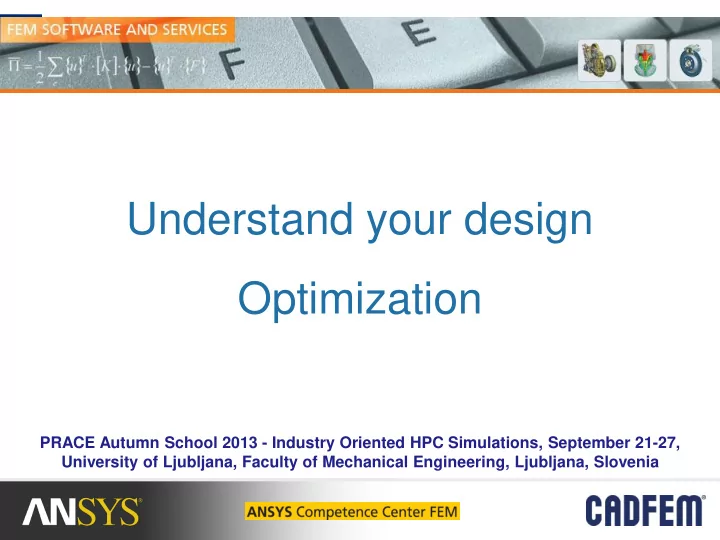

Understand your design Optimization PRACE Autumn School 2013 - Industry Oriented HPC Simulations, September 21-27, University of Ljubljana, Faculty of Mechanical Engineering, Ljubljana, Slovenia
Optimization Table of contents 1. General Information 2. Optimization Algorithms - 2 -
Optimization 1. General Information Workflow: xxx Sensitivity study CAD and CAE Parameter definition minimize Define optimization goal and optimize Validate optimized design - 3 -
Optimization General Information Design variables Start Variables defining the design space ? (continuous, discrete, binary) Objective function Function f ( x ) has to be minimized Constraints, State variables Constrain the design space, Equality/Inequality restrictions are possible - 4 -
Optimization 2. Optimization Algorithms Available Optimization algorithms in optiSLang: - 5 -
Optimization Optimization Algorithms Decision Tree: - 6 -
Optimization Optimization Algorithms optiSLang inside Workbench chooses the best algorithm by a wizard: - 7 -
Optimization Optimization Algorithms Nonlinear Programming Quadratic Line Search (NLPQL) Start ? Recommended area of application: reasonable smooth problems Remark: The gradient optimizer sometimes stucks in local optima Also use with care for binary/discrete variables - 8 -
Optimization Optimization Algorithms Adaptive Response Surface Method: + Fast catch of global trends, smoothing of noisy answers + Adaptive RSM with D-optimal linear DOE/approximation functions for optimization problems with up to 5…15 continuous variables is possible - 9 -
Optimization Optimization Algorithms Adaptive Response Surface Method: Design variable 2 1. Iteration objective 3. Iteration Design variable 1 objective Design variable 2 5. Iteration objective Design variable 1 - 10 -
Optimization Evolutionary algorithm (EA) It imitates Evolution (“Optimization”) in Nature: Survival of the fittest Evolution due to mutation, recombination and selection Developed for optimization problems where no gradient information is available, like binary or discrete search spaces Evolution Strategies [ES] Genetic Algorithms [GA] - 11 -
Optimization Particle Swarm Optimization (PSO) - swarm intelligence based biological algorithm - imitates the social behaviour of a bees swarm searching for food Selection of swarm leader including archive strategy Adaption of fly direction Mutation of new position Available for single/multi objective Optimization - 12 -
Optimization Simple Design Improvement Improves a proposed design without extensive knowledge about interactions in design space Start population by uniform LHS around given start design The best design is selected as center for the next sampling The sampling ranges decrease with every generation - 13 -
Optimization Gradient-based Response surface Biologic Algorithms algorithms method • GA/EA/PSO copy • Most efficient method • Attractive method mechanisms of nature to if gradients are for a small set of improve individuals accurate enough continuous • Method of choice if variables (<15) • Consider its gradient or ARSM fails • Adaptive RSM with restrictions like • Very robust against local optima, only default settings is numerical noise, non- continuous variables the method of linearities, number of and noise choice variables,… Start - 14 -
Optimization 1) Start with a sensitivity study using 2) Identify the important parameters the LHS Sampling and responses - understand the problem - reduce the parameters Scan the whole Design Space Understand the optiSLang Problem using CoP/MoP Search for Optima 3) Run the suiting optimization algorithm 4) Goal: user-friendly procedure provides as much automatism as possible - 15 -
Optimization Objective 1: minimize maximum amplitude after 5s Objective 2: minimize eigen-frequency DOE scan with 100 LHS samples gives good problem overview Weighted objectives require about 1000 solver calls - 16 -
Optimization Strategy C: Pareto Optimization - 17 -
Optimization Design space Objective space • Only for conflicting objectives a Pareto frontier exists • For positively correlated objective functions exactly one optimum exists - 18 -
Optimization Conflicting objectives Correlated objectives - 19 -
Optimization Gradient-based Local adaptive RSM Biologic Algorithms algorithms Start Response surface Global adaptive RSM Pareto Optimization method (RSM) - 20 -
Recommend
More recommend